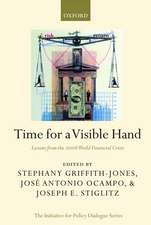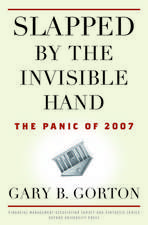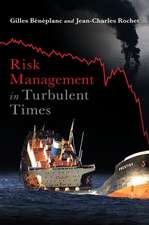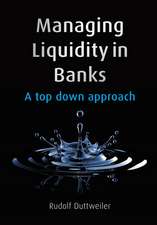Risk Culture in Banking: Palgrave Macmillan Studies in Banking and Financial Institutions
Autor Alessandro Carretta, Franco Fiordelisi, Paola Schwizeren Limba Engleză Hardback – 23 oct 2017
| Toate formatele și edițiile | Preț | Express |
|---|---|---|
| Paperback (1) | 1112.60 lei 6-8 săpt. | |
| Springer International Publishing – 23 aug 2018 | 1112.60 lei 6-8 săpt. | |
| Hardback (1) | 1117.99 lei 6-8 săpt. | |
| Springer International Publishing – 23 oct 2017 | 1117.99 lei 6-8 săpt. |
Din seria Palgrave Macmillan Studies in Banking and Financial Institutions
- 9%
 Preț: 1028.24 lei
Preț: 1028.24 lei - 17%
 Preț: 359.43 lei
Preț: 359.43 lei - 9%
 Preț: 907.70 lei
Preț: 907.70 lei - 15%
 Preț: 694.04 lei
Preț: 694.04 lei - 15%
 Preț: 638.43 lei
Preț: 638.43 lei - 15%
 Preț: 643.34 lei
Preț: 643.34 lei -
 Preț: 389.11 lei
Preț: 389.11 lei - 15%
 Preț: 669.97 lei
Preț: 669.97 lei - 15%
 Preț: 642.51 lei
Preț: 642.51 lei - 15%
 Preț: 642.51 lei
Preț: 642.51 lei - 15%
 Preț: 649.06 lei
Preț: 649.06 lei - 15%
 Preț: 639.25 lei
Preț: 639.25 lei - 15%
 Preț: 640.06 lei
Preț: 640.06 lei - 18%
 Preț: 752.88 lei
Preț: 752.88 lei - 15%
 Preț: 640.06 lei
Preț: 640.06 lei - 15%
 Preț: 645.47 lei
Preț: 645.47 lei - 18%
 Preț: 884.35 lei
Preț: 884.35 lei - 15%
 Preț: 641.20 lei
Preț: 641.20 lei -
 Preț: 386.39 lei
Preț: 386.39 lei - 15%
 Preț: 643.34 lei
Preț: 643.34 lei -
 Preț: 388.72 lei
Preț: 388.72 lei -
 Preț: 396.40 lei
Preț: 396.40 lei - 15%
 Preț: 642.51 lei
Preț: 642.51 lei - 15%
 Preț: 638.76 lei
Preț: 638.76 lei - 15%
 Preț: 639.73 lei
Preț: 639.73 lei - 15%
 Preț: 637.59 lei
Preț: 637.59 lei -
 Preț: 387.75 lei
Preț: 387.75 lei - 15%
 Preț: 641.20 lei
Preț: 641.20 lei - 15%
 Preț: 640.88 lei
Preț: 640.88 lei -
 Preț: 389.70 lei
Preț: 389.70 lei - 15%
 Preț: 648.24 lei
Preț: 648.24 lei - 15%
 Preț: 638.43 lei
Preț: 638.43 lei - 15%
 Preț: 641.20 lei
Preț: 641.20 lei - 15%
 Preț: 638.76 lei
Preț: 638.76 lei -
 Preț: 391.61 lei
Preț: 391.61 lei - 15%
 Preț: 641.20 lei
Preț: 641.20 lei - 15%
 Preț: 643.34 lei
Preț: 643.34 lei - 15%
 Preț: 641.71 lei
Preț: 641.71 lei -
 Preț: 390.63 lei
Preț: 390.63 lei - 15%
 Preț: 641.71 lei
Preț: 641.71 lei - 15%
 Preț: 644.95 lei
Preț: 644.95 lei - 15%
 Preț: 645.79 lei
Preț: 645.79 lei - 15%
 Preț: 645.79 lei
Preț: 645.79 lei - 15%
 Preț: 638.76 lei
Preț: 638.76 lei - 15%
 Preț: 640.06 lei
Preț: 640.06 lei - 15%
 Preț: 640.06 lei
Preț: 640.06 lei - 15%
 Preț: 643.34 lei
Preț: 643.34 lei - 15%
 Preț: 642.51 lei
Preț: 642.51 lei - 15%
 Preț: 640.06 lei
Preț: 640.06 lei - 18%
 Preț: 1125.86 lei
Preț: 1125.86 lei
Preț: 1117.99 lei
Preț vechi: 1363.40 lei
-18% Nou
Puncte Express: 1677
Preț estimativ în valută:
213.92€ • 223.96$ • 177.01£
213.92€ • 223.96$ • 177.01£
Carte tipărită la comandă
Livrare economică 07-21 aprilie
Preluare comenzi: 021 569.72.76
Specificații
ISBN-13: 9783319575919
ISBN-10: 3319575910
Pagini: 509
Ilustrații: XXIX, 436 p. 47 illus.
Dimensiuni: 148 x 210 x 31 mm
Greutate: 0.71 kg
Ediția:1st ed. 2017
Editura: Springer International Publishing
Colecția Palgrave Macmillan
Seria Palgrave Macmillan Studies in Banking and Financial Institutions
Locul publicării:Cham, Switzerland
ISBN-10: 3319575910
Pagini: 509
Ilustrații: XXIX, 436 p. 47 illus.
Dimensiuni: 148 x 210 x 31 mm
Greutate: 0.71 kg
Ediția:1st ed. 2017
Editura: Springer International Publishing
Colecția Palgrave Macmillan
Seria Palgrave Macmillan Studies in Banking and Financial Institutions
Locul publicării:Cham, Switzerland
Cuprins
Chapter 1: Introduction.- Chapter 2: Risk culture.- Chapter 3: Risk culture in different bank business.- Chapter 4: Risk culture in the regulation & supervision framework.- Chapter 5: Internal controls and risk cultures in banks.Chapter 6: Soft tools: HR management, leadership, diversity.- Chapter 7: Measuring and assessing risk culture.- Chapter 8: Impact on bank reputation. Chapter 9: Watchdog or Petdog: Do the media play a role in shaping banks risk culture?.- Chapter 10: Influence of National Culture on Bank Risk-Taking in the European System.- Chapter 11: Risk-taking of European banks in CEECs: the role of national culture and stake vs shareholder view.- Chapter 12: Risk culture in different bank business models: the case of real estate financing.- Chapter 13: Supporting an effective risk culture in private banking & wealth management.- Chapter 14: Appetite for Risk and Financial Literacy in Investment Planning.- Chapter 15: Bank credit risk management and risk culture.- Chapter 16: Credit rating culture.- Chapter 17: Accounting conservatism and risk culture.- Chapter 18: Auditing risk culture.
Notă biografică
Alessandro Carretta is a Full Professor of Economics and Management of Financial Intermediation at the University of Rome Tor Vergata, Italy. He has been teaching banking and finance for more than 35 years, formerly at the Universities of Urbino, Lecce and Milan Bocconi, Italy. His main research interests relate to banking management, focusing on banking groups and diversification, regulation and control, corporate governance, and culture and organizational change in banks.
Franco Fiordelisi holds a chair in Banking and Finance at the University of Rome III, Italy. He is also a part-time Professor of Finance at Middlesex Business School in London, UK, and senior affiliated Faculty Member at the Bocconi Business School in Milan, Italy. Franco’s work has been published in international academic journals such as the Journal of Financial and Quantitative Analysis, Review of Finance, Journal of Corporate Finance, and Journal of Banking and Finance. He is currently associate editor of the European Journal of Finance.
Paola Schwizer is a Full Professor of Financial Markets and Institutions at the University of Parma, Italy, where she teaches risk management and value creation in banks and financial markets and institutions. She is Professor at the SDA Bocconi School of Management, Italy, and President of Nedcommunity, the Italian Association of non-executive and independent directors and a member of the board of directors of ecoDa, the European Confederation of Directors' Associations in Brussels, Belgium. Paola is also a member of the editorial board of the Journal of Management and Governance.
Franco Fiordelisi holds a chair in Banking and Finance at the University of Rome III, Italy. He is also a part-time Professor of Finance at Middlesex Business School in London, UK, and senior affiliated Faculty Member at the Bocconi Business School in Milan, Italy. Franco’s work has been published in international academic journals such as the Journal of Financial and Quantitative Analysis, Review of Finance, Journal of Corporate Finance, and Journal of Banking and Finance. He is currently associate editor of the European Journal of Finance.
Paola Schwizer is a Full Professor of Financial Markets and Institutions at the University of Parma, Italy, where she teaches risk management and value creation in banks and financial markets and institutions. She is Professor at the SDA Bocconi School of Management, Italy, and President of Nedcommunity, the Italian Association of non-executive and independent directors and a member of the board of directors of ecoDa, the European Confederation of Directors' Associations in Brussels, Belgium. Paola is also a member of the editorial board of the Journal of Management and Governance.
Textul de pe ultima copertă
This book explores risk culture in banks following the financial crisis. It analyses the role of national and institutional risk culture, market competitiveness, organisational systems and institutional practices that led to a weakening of risk culture in financial institutions leading up to the financial crisis. It addresses how to assess and measure risk culture, and analyse the impact on performance and reputation. Finally it explores the impact of regulation and a variety of tools that can be applied from the board down to promote a healthy risk culture in the governance of financial institutions internal controls and risk culture in banks.
Caracteristici
Explores the importance of risk culture in ensuring financial stability Analyses how to measure risk culture Proposes measures to promote a healthy risk culture Contributes to the discussion on banking regulation Includes supplementary material: sn.pub/extras Includes supplementary material: sn.pub/extras















